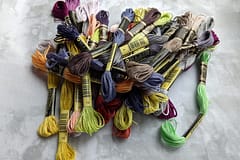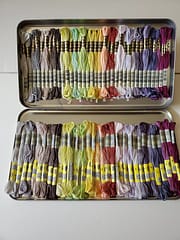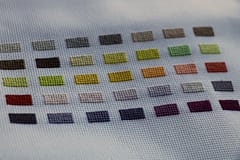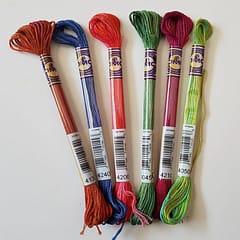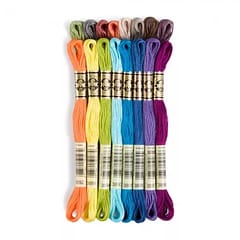Are There Problems With the 01-35 DMC Thread Colors?
When Pattern Making Goes Wrong
Contents
- DMC - Exceptional Quality Control
- ”Dye Lot” Claim
- Software Palette Issue
- Color Mapping Explained
- Solutions
- Conclusion
Introduction
Are There Problems With the 01-35 DMC Thread Colors?
There’s recently been some controversy surrounding the new 01-35 DMC threads. These were a set of new thread colors released in late 2017 which filled in some gaps in the DMC palette. It’s probably getting to the point where we should drop the ‘new’ prefix but they have been a useful addition to the range and if you create a pattern with software that knows about them, they should provide smoother color changes where they are used rather than the software having to use a thread color that doesn’t match quite so well, as it would have had to before they were available.
Of course, that assumes that the software really does know about the colors. What if what it thinks it knows is wrong? In that case the software will pick threads that it thinks are the closest to best represent the colors in the image but when a piece is actually stitched, the real colors of those threads could be noticeably different and produce strange visual anomalies. Areas that should represent darker shadow areas in an image for instance could end up being lighter than the non-shadow areas. Colors that should be rich and saturated could be dull and bland and so on. Having poorly matched colors would make a piece look strange and ‘off’.
So where’s the controversy?
Well, it turns out that a well known pattern-making company (we’re not going to name names) has been producing cross-stitch patterns for the past few years using software that may not actually have an accurate enough knowledge of the new thread colors. So some of the charts they made seem to have an issue with color but it’s been suggested that the issue was actually with DMC threads, specifically “dye lots” creating color differences.
So is there an issue with 01-35 DMC thread colors or a problem with certain patterns?
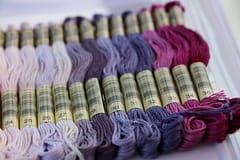
DMC - Exceptional Quality Control
Let us make this very clear: THERE IS NO PROBLEM WITH DMC THREAD. We’re still seeing people make these claims without any evidence and there is no basis to them.
DMC make exceptionally high quality thread with incredible quality control and there is no evidence that there has been any issue with it at all. In fact, to test the claims we went out and bought another collectors tin of the new 01-35 colors from Michaels in Canada. Our original tin was purchased 3 years ago from the UK. There is no way these were from the same dye lot. Below are some photographs showing how precisely the two sets of thread colors match.
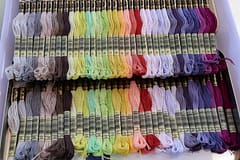
As you can see, DMC do an amazing job of consistently producing threads of the same color - it’s why you can go to any craft store to buy a skein you need and be confident that it will be the color that the pattern calls for and a practically identical match for any existing skein you have.
You can trust DMC thread colors!
”Dye Lot” Claim
The only time that “dye lots” are a consideration is if you were stitching large solid blocks of the same color where even very slight variations (for certain thread colors) might be noticeable if you switched between them part way through.
To test this out, we also purchased some single-skeins of the new colors which again, are certainly from a different dye lot, and stitched some solid blocks of them together with our original 3-year old UK-sourced skeins to see how close they were.
Can you see any difference? Can you even tell which way they are split? The two blocks are of thread colors 08 and 09 respectively with the top half of each from a 3 year old UK sourced skein and the bottom half one we bought today in Canada.
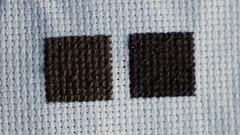
Although claiming “dye lots” are responsible sounds ‘credible’ (because very-slight color changes are what dye lots can produce), this goes way beyond any dye lot issue - they would never result in completely different colors entirely to the extent that is impacting patterns.
Here are some individually purchased skeins against the UK box set:
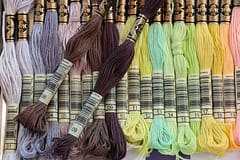
We purchased skeins from different continents 3 years apart and they matched incredibly well. It’s pretty astounding when you think about it.
Software Palette Issue
The real cause of the issue is that the off-the-shelf software used to convert images to patterns appears to have had an incorrect specification of the new colors. This was likely introduced when the new colors were added as part of a software update and we suspect that the method they used to sample the new colors was different somehow to whatever process was used for the original 447 colors done many years earlier. It could have been several typos with some digits of colors transposed but in our experience, these rarely produces colors anywhere close to the one intended so would likely have been noticed and would have produced dramatically wrong patterns.
It’s more likely that a different method was used and this resulted in two sets of colors that didn’t quite go together. This is difficult to explain but as an analogy, imagine that you have a piano which is tuned a little too high. Each key is tuned relative to all the others OK, so you could play a tune and it would sound perfectly fine. You also have a guitar and it too has all the strings tuned relatively with each other so that it sounds fine when played, but it’s tuned slightly lower overall than it should be. On their own, each instrument is fine and would produce good results - you just couldn’t play a song using them together and the results be harmonious.
This is what the palette situation appears to be. If one block of colors is lighter and more saturated for instance, and another set less saturated and slightly darker, neither is dramatically wrong on their own, but they just don’t work well together. They won’t produce a harmonious result and that can have a devastating effect on the quality of a piece when stitched.
The net result is that the software had a slightly inconsistent view of what the full DMC color palette was and so will have been making some incorrect choices when matching image colors to threads.
We can’t say for certain that is how it happened and unfortunately, after many years of supporting the software, the vendor has decided to shut down this business and move on to other opportunities so future updates may not be available.
But we do know it is a software palette issue because it affects the same patterns consistently and other pattern vendors who use the same software corrected the palette that they used. It’s unclear if this was due to them being notified of the issue by the software vendor or because they noticed the color discrepancies themselves through some other process.
Color Mapping Explained
It’s hard to explain the palette issue without describing a lot of the science behind color-theory which really is a most fascinating subject but would take far too long to explain here and, well, a lot of math (the kind with strange squiggles), so I’ll try to explain it with a simplified analogy.
Imagine colors are simple numbers - yes, they are often represented as 3 numbers for the amount of red, green, and blue, but just think of a single value that has to be matched against for now and this is the color value itself, nothing to do with any numeric code assigned to them.
Suppose the world of digital images is made up of only 12 colors instead of the 16 million + possible representation we really have. We would have colors in a digital image with values 01 to 12. It would be a strange and surreal alien world that we lived in, like an early episode of Star Trek with what I imagine psychedelic drugs are like.
The maker of threads in this color-simple alien world produces 4 different threads, spread across the spectrum, so anytime there isn’t an exact color match we would pick the closest numeric value that does exist. This is exactly what happens in our color-rich world, except DMC make 482 colors to pick from.
The colors could be matched like this by a program:
Real colors : 01 02 03 04 05 06 07 08 09 10 11 12 Thread available: 02 04 08 11 Matched colors : 02 02 02 04 04 04 08 08 08 11 11 11
Note that colors 03 and 06 are each exactly half way between two matches, so which should the software pick? In reality, this rarely happens but for higher quality results the best software will also take the surrounding image color matches into account when evaluating which color to use rather than having a fixed lookup.
Hopefully you’re still with me …
Now imagine that the software thinks the thread colors available are different to what they actually are and it’s been incorrectly programmed to think that the 08 color really looks like 05. What would happen when the software converted an image?
Real colors : 01 02 03 04 05 06 07 08 09 10 11 12 Thread available: 02 04 08 11 Matched colors : 02 02 02 04 08 08 08 11 11 11 11 11
Some of the colors that were previously matched as being closer to the 04 thread are now incorrectly matched as closer to 08 (because the software is seeing it as 05). Likewise, some of the threads that previously matched as closer to 08 now instead match with 11 which is actually further away than the real thread color.
Even though only one thread color was wrong it’s affected the 05, 06, 08, and 09 colors in the image. Notice, it even fails to match the exact color 08 with itself, because it just doesn’t know that 08 is the real thread color.
The pattern for this image would be messed up and look wrong when stitched with the actual thread even though it might not look obviously wrong in a preview (although some issues should be noticeable). It would look roughly right when stitched but a bit “off” - it wouldn’t really look “right” at all, certainly not as high quality as you would hope and expect. And it’s not just a case of now replacing the 08 color or 11 color to fix it - the whole pattern will never look as good as it should unless it is re-created with a corrected palette. It can’t be corrected in the pattern alone as the information has been permanently lost with the incorrect palette mapping.
There is no color that can be replaced in the second set of matches to turn it in to the first set of matches. There is no simple replacement thread fix.
Solutions
One solution they are trying is to replace individual thread colors where they have been used in the pattern. Unfortunately, we’ve just seen why this is unlikely to work well and produce good results. It may look like it kind-of works for some patterns, and mask the problem to some degree, but they will never come out as good as they really should.
It’s important to note that while focus has been on two colors, 08 and 09, that have been most noticeable in certain patterns, we haven’t seen any evidence that the issue is solely limited to those two colors alone. They simply may be the most noticeable or the first to be noticed in the context of the pieces affected.
Unfortunately, for people who may have already invested significant $$$, time and effort into a piece this may be the only, and least-worst, option. Even then, depending on the fabric and nature of the change, it may really make the piece unsalvageable.
It also requires people put even more effort into completing pieces that they know there are serious issues with and just “hope and trust” that it will work out in the end … that sounds like a heavy expectation to make especially when some of the thread replacements have looked rather poor in previews.
For non-started pieces and future sales, the only real solution is to re-chart these patterns using a corrected palette. As demonstrated earlier, changing the color definition of a thread in the palette after charting doesn’t just impact that thread alone in the pattern. If the pattern is re-charted, many other stitches will often change and the software will possibly even pick a slightly different palette to use. It will rarely, if ever, produce an identical pattern with just that single thread’s stitches replaced.
This is why the ‘quick fix’ solution doesn’t really work other than as a band-aid for in-progress pieces. New pieces should not be started with those patterns.
Conclusion
It’s a horrible situation and our heart goes out to anyone impacted by this issue, especially those who have only discovered it after committing so much to their project.
While the company involved is still working to rectify the issue (and we hope they come up with a proper solution) we thought it important to address some of the initial mis-information relating to the claim of dye-lot issues that was perhaps put out inadvertently but has been widely circulated and is unfortunately still being repeated on social media so hasn’t received enough of a correction.
We also think it’s unfair to the greater cross-stitching community to introduce uncertainty and doubt about DMC’s threads as this also impacts other stitchers and pattern makers, ourselves included, even though we are completely unaffected. When we started thread-bare we invested a considerable amount of time and money into creating an accurate color palette and together with the advanced color matching algorithms it’s one of the reasons our patterns always come out looking like the preview shown on the screen.
The mis-information also risks convincing people to abandon perfectly good pieces that are totally unaffected, just because they contain some of the thread colors that they have been lead to believe are somehow “wrong”. That would be equally tragic as those who’s pieces have actually been ruined because of the mis-match.
We hope the work we’ve done to demonstrate the quality and consistency of DMC threads reassures people that there isn’t any issue with the threads or their use in patterns - they are a very useful addition to the color range and their inclusion in any pattern is normally a measure that they filled a gap in the palette and provided a better match than one of the pre-existing colors for that image.
